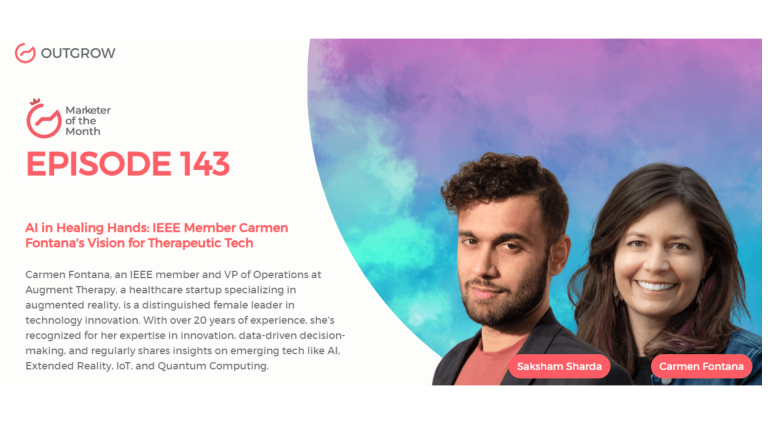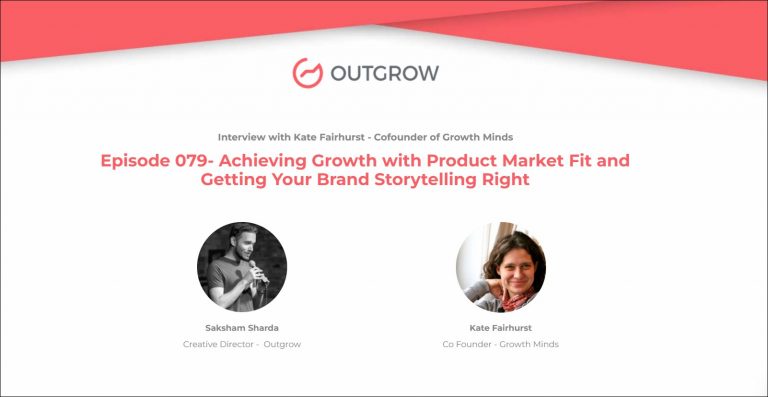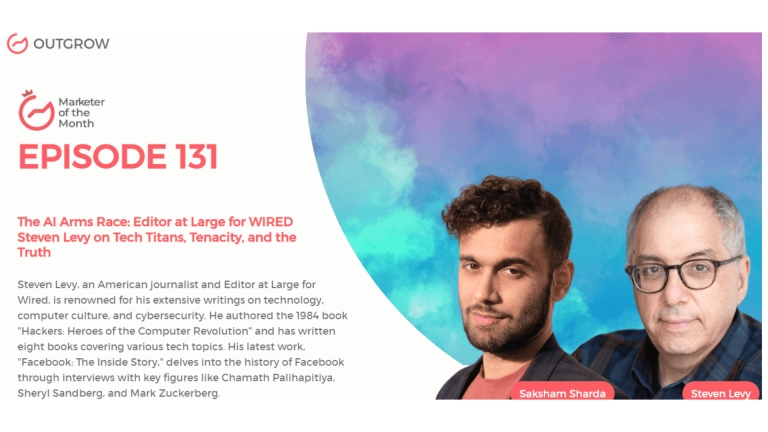EPISODE 205: Marketer of the Month Podcast with Charith Mendis
Table of Contents
Hey there! Welcome to the Marketer Of The Month blog!
We recently interviewed Charith Mendis for our monthly podcast – ‘Marketer of the Month’! We had some amazing insightful conversations with Charith and here’s what we discussed about –
1. AWS’s role in enhancing call center operations, personalization, operational efficiency, and risk understanding.
2. Tailored strategies for banks’ unique needs, focusing on end goals and specific use cases.
3. Regulations as a constant, not a hindrance, to cloud adoption in the banking industry.
4. Emphasis on AWS’s security measures, encryption methods, and customer-defined data storage practices.
5. Integration of generative AI, shifting towards conversational interfaces and NLP.
6. The importance of working backward from the customer needs to avoid rework and inefficiencies.
7. Enhancing operations through hyper-personalization, propensity models, lending operations, and call center capabilities.
About our host:
Dr. Saksham Sharda is the Chief Information Officer at Outgrow.co. He specializes in data collection, analysis, filtering, and transfer by means of widgets and applets. Interactive, cultural, and trending widgets designed by him have been featured on TrendHunter, Alibaba, ProductHunt, New York Marketing Association, FactoryBerlin, Digimarcon Silicon Valley, and at The European Affiliate Summit.
About our guest:
Charith Mendis is the Head of the Worldwide Banking Industry for Amazon Web Services (AWS), where he oversees global banking industry activities. With over 15 years of experience in financial services across Asia, EMEA, and North America, he helps banking and lending organizations leverage cloud capabilities to innovate and transform their operations.
Banking on the Cloud: Amazon Web Services’ Head of Worldwide Banking Industry Charith Mendis on How to Drive Market Growth
The Intro!
Saksham Sharda: Hi, everyone. Welcome to another episode of Outgrow’s Marketer of the Month. I’m your host, Dr. Saksham Sharda, and I’m the creative director at Outgrow. co. And for this month we are going to interview Charith Mendis who is the Head of Worldwide Banking Industry at Amazon Web Services.
Charith Mendis: Great to be here. Thank you.
Don’t have time to read? No problem, just watch the Podcast!
Challenge yourself with this trivia about the exciting topics Charith Mendis covered in the podcast.
Or you can just listen to it on Spotify!
The Rapid Fire Round!
Saksham Sharda: So let’s start with the rapid-fire rounds. The first one is, at what age do you want to retire?
Charith Mendis: 45.
Saksham Sharda: How long does it take you to get ready in the morning?
Charith Mendis: It’s about 30 minutes.
Saksham Sharda: Most embarrassing moment of your life?
Charith Mendis: That’s a hard one. I don’t know if there’s a most embarrassing moment. There are probably just too many to count.
Saksham Sharda: Favorite color?
Charith Mendis: Black.
Saksham Sharda: What time of day are you most inspired?
Charith Mendis: Probably between 6 to 8:00 AM.
Saksham Sharda: How many hours of sleep can you survive?
Charith Mendis: About 6. I could get by with 4 if I need to.
Saksham Sharda: Fill in the blank. An upcoming finance trend is ______.
Charith Mendis: Oh, I’ll take that one again. An upcoming finance trend is groundbreaking.
Saksham Sharda: How do you relax?
Charith Mendis: Usually running, playing squash, or sitting in the sauna.
Saksham Sharda: How many cups of coffee do you drink per day?
Charith Mendis: One Espresso.
Saksham Sharda: A habit of yours that you hate?
Charith Mendis: Waking up too early.
Saksham Sharda: The most valuable skill you’ve learned in life.
Charith Mendis: Being adaptable.
Saksham Sharda: Your favorite Netflix show.
Charith Mendis: Oh, Mindhunters.
Saksham Sharda: One-word description of your leadership style.
Charith Mendis: Consultative.
Saksham Sharda: Top priority in your daily schedule.
Charith Mendis: Meeting with customers.
Saksham Sharda: Ideal vacation spot for relaxation.
Charith Mendis: Custody.
Saksham Sharda: Key factor for maintaining a work-life balance.
Charith Mendis: Focusing on work-life harmony as opposed to balance.
The Big Questions!
Saksham Sharda: Okay. That’s the end of the round. So let’s go to the long-form questions, which you can now answer as much time and ease as you like.
Saksham Sharda: Can you share some key insights into how AWS is driving digital transformation in the banking industry?
Charith Mendis: Yeah, I mean, there’s a lot. Yeah. So like, when we think about how our customers are using AWS and cloud services, it’s across all parts of the value checking banking from driving better call center operations to better personalization using machine learning through to the middle office, and being able to improve kind of the operational efficiency in the middle office. And also a better understanding of risks. We’ve got other customers across the globe who are implementing core banking solutions and others who are doing embedded banking or banking as a service as well. So when you think about how AWS is being used, it’s actually probably across all different parts of the banking value use case, and being able to really drive that either operational efficiency or that customer experience or that increased insight is how our customers use our services.
Saksham Sharda: And so do you have a memorable example of a banking client that successfully transformed their operations? Any story that stands out?
Charith Mendis: I mean, like so many here, like when you think about what you’ve seen with what Nawe has shared in terms of how they’ve been able to drive personalization or you hear about what standard China Bank has done with their banking as a service capability. Many other examples like that stand out in terms of being able to drive that transformation both inside the organization, and also being able to impact their customer outcomes.
Saksham Sharda: So where do you think banking as a service is headed?
Charith Mendis: I think it’s on this evolutionary track. I think what it means to provide banking as a service, whether it’s specific APIs or full banking license capability as banking as service, I think we are seeing that occur in different areas based on need, whether that’s in Vietnam, which is occurring more like banking as a service or very specific APIs as we see in the US. So I don’t think there’s an end state or I could predict the end state for it, but I think what we’re seeing is that it’s being used to drive embedded banking and serve those customers with an immutable need in their customer journey. And that’s where we see it being really applicable and a lot of customers using it to drive better outcomes from a banking point of view.
Saksham Sharda: So with regards to cloud strategies, then, how do you approach developing cloud strategies for banking organizations with different needs and challenges across various regions?
Charith Mendis: Yeah, and I think the point in your question, the last one is probably the most important. All banks have different needs and challenges. So when you think about developing a cloud strategy or a digital transformation strategy, there is no one size fits all. Okay? So what we like to do at Amazon is work backward from the end customer’s goal along with the bank. So how do we actually drive from an outcome and an immutable need to solve the intrinsic problem? So you’re not doing cloud for the sake of cloud, you’re actually doing it for a use case. So when I was talking earlier about those different use cases, it really depends on the bank’s trying to drive better personalization. So we’re starting to touch with machine learning or they’re trying to drive operational efficiency where it is, maybe it’s a combination of machine learning and partner solutions, or they’re trying to exit their data center, and that could be more of a migration activity. So it just depends on what the customer’s trying to do to drive how we approach a transformation. But we always work back from that immutable need that our customers have.
Saksham Sharda: If you had to highlight the primary benefits you see for banks adopting AWS’s cloud-native services, what would they be?
Charith Mendis: I think there are quite a few. But you know, at a high level, what I would say is it’s better scale and better flexibility in terms of what they’re trying to deliver to their customers. It’s increased security and a better security footprint that they’re able to get from an AWS point of view, we see customers driving better resiliency in their core applications that they drive, and then it’s the agility to meet the market demand as customers iterate and their consumers iterate in terms of their needs. So by being able to leverage AWS services, what customers are able to do is focus on what’s most important to them, which is their core business of delivering banking or financial services to their customers as opposed to managing infrastructure, which we do on behalf of those customers.
Saksham Sharda: How do you address concerns around data security and compliance in these cloud data solutions?
Charith Mendis: So all of our customers focus on how they define their data security platform, etc. Now, AWS job zero is security for us and making sure the cloud is secure from what we build and what we provide to our customers. Then customers on top of that, obviously secure their data using encryption methodologies, things like KMS, etc to be able to encrypt data both in transit and at rest. They also define where their data is stored and where it can be moved. So we find that our customers leverage the machine learning tools that we provide to better help encrypt and secure their data while AWS manages the cloud and helps ensure the environment from a cloud on view is secure as well.
Saksham Sharda: How are you guys leveraging AI and machine learning in your cloud solutions to enhance banking operations and customer experiences?
Charith Mendis: Yeah, and I think it’s how banks probably use that and how we provide those services to their customers. And there’s a number of things, as I said, from driving hyper-personalization to driving better propensity models to helping our banking customers drive lending operations or being able to use Journey AI to be able to do some of that manual lift of knowledge workers. We see all of those different areas where banks are adopting AI and all technologies, either pre-built into our services like our Amazon Connect product that provides call center capabilities or using Bedrock or Amazon Bedrock to be able to use generative AI to experiment and roll out generative AI solutions that meet the needs of the banking industries.
Saksham Sharda: So in what ways do you actually measure the impact of AI and ML implementations like these on a bank’s performance?
Charith Mendis: So usually banks, when they look at using AI ml or any other technology usually do so as I said, in terms of that immutable need. So what are they trying to solve? So I’m a strong believer that you don’t try to measure the impact of AI as an AI capability, but you’re trying to measure the ability of that technology or that toolset to impact the outcome of the bank. So that could be something as improving NPS, that could be a better prediction model. It could be a lower amount of churn, or it could be operational efficiency. So when you think about the use of IML and how bags are truly measuring the impact of that on their organization, it’s against those standard business drivers that we always saw in the Organization.
Saksham Sharda: So where do you actually see the use of AI and ML and Gen AI in the FSI heading?
Charith Mendis: That’s a really interesting question. So I think, you know, the really good thing for financial services and banking customers is data has always been a focus in terms of the financial service industry in terms of getting that data right, getting that data consolidated and usable. Now, when you think about overlaying generative AI and AI, ML, and some of the other techniques, what you’re seeing is banks in a great position to leverage these tools because their data is correct. Now, when you put my, you know, crystal ball or stargazing hat on, what I would say is, you know, I think what’s gonna change is the human-to-computer interface in corporate life. Okay? We’ve already seen that in our retail life or in our individual lives where I can talk to Alexa or I talk to Siri. Now. I think what we’re seeing from a corporate point of view is that same idea, being able to ask a chatbot a question about a load or a customer and being able to get a natural language answer back. We are seeing that change in corporate life, which was previously very application-focused, and now we’re seeing it become more conversational flow as we see in our personal lives with the devices we have today.
Saksham Sharda: So would it be like the depth of applications in general?
Charith Mendis: I don’t think so. I don’t think it’s gonna be the depth of applications. I think it’s more how you surface that at the moments of need. So really, you know, the applications, whether it’s a loan origination system, more core banking system, are gonna be crucial to what we do in banking from now till, you know, I think forever. But like, how do you surface that in the context of Chad just calling me and wanting to inquire about where my loan is today and what the next step is required? Now I have the option of logging into the application, finding the way the loan is and finding that item, or being able to take a natural language question, which is, can you give me an update on my loan and what’s the next step? And being able to use Generative AI and data capabilities to be able to ask that question of the data and respond with a natural language answer, whether that’s human in the loop, whether that’s at some stage without the human in the loop, I think we’ll get to that stage. But like you see that model in terms of being able to ask a natural language question and get a natural language answer in the same way that today I’m sure you ask Alexa, you know, tell me a good recipe to make with my leftover meatballs that I have in the fridge as an example.
Saksham Sharda: So what are the challenges you’ve seen in this? What hasn’t worked till now and why?
Charith Mendis: I Think there are challenges across the board. I, I mean, I think, you know, as, as with any technology, as with anything that you’re doing, it’s really important that you focus on having top-down leadership to drive the capability you need to have clear metrics in terms of what you are going to drive towards an immutable need that you’re solving for, to, to make transformation sticky. Okay. So what I see that hasn’t worked generally is when we think about the problem as a technology as opposed to the immutable need that we’re solving for. So a lot of the banks that I work with are using Genive AI or AI ML to solve a specific banking need, a specific end-user need, or a specific customer need. But if you’re trying to solve generative AI in the bank, it’s a little bit more esoteric and it forces you to kind of just think about the technology as opposed to the end need that you’re solving for. And that’s what I see not working as well.
Saksham Sharda: Can you share any cases where AI and ML or Gen AI projects faced significant hurdles and how these were overcome?
Charith Mendis: Nothing where I would say significant hurdles. I think when we think about all of these, it’s making sure that you’ve, as I come back to, you know, focusing on that in need when it hasn’t been clear. There’s been rework that I’ve seen customers needing to do in the industry more broadly. But nothing that I would say is a significant hurdle from what I’ve seen, at least for customers that are leveraging AWS because when we work with our customers in these kinds of spaces, it is very much working backward from customer needs and as opposed to, as I was saying earlier, just solving for ai. And now generically,
Saksham Sharda: Let’s go onto a lighter question now. What does your typical day at AWS look like? You wake up in the morning and then?
Charith Mendis: I think the typical day is very different. So, you know, it’s a range of things like this that I’m doing today at 20 20 20 through to meeting with customers to talk about their pressing needs, working with our partners in the industry to help them build the core banking or lending operation capabilities that our customers use to working with my team to, you know, figure out and work through our strategy for the next three years. So I would say my day is quite mixed and no one day is the same, but a lot of what I do is very much focused on helping our banking customers drive their transformation more broadly.
Saksham Sharda: And how much of it is taken up by meetings?
Charith Mendis: I would say not that much. I, you know, obviously when I meet customers you could count that as a meeting, but you know, I find that less so about an internal meeting. I think we’ve, the question more about an internal meeting. Probably a very small amount of my time is spent in internal meetings. I spend most of my time with customers and partners.
Saksham Sharda: Right. So let’s go back to talking about Gen Ai again since everybody’s talking about it. There have been a lot of tech fads over the years. Is Gen Ai another one? Is Gen AI different? Why should bankers care?
Charith Mendis: So again, I come back to Gen AI as a tool, it’s a capability just in the same way that AI is, etc. I think the reason why we think, or I think it’s not just a fad, is it’s actually helping drive a solution for a business problem that we have. Okay. So humans don’t communicate in structured sentences to be able to do a query. Okay? We communicate in natural language where we have different intonations and different ways of speaking. I’m from Australia, I speak differently to my American colleagues just because of the language skills that I learned versus the language skills. They learn what generative AI does. It helps us kind of interpret that language and respond in the natural language process. It can infer intent, it can infer. So I don’t think it’s a fad in terms of the technology, but it’s really about the application of that to a specific need. So will it work for every single use case? No, it’s a combination of traditional AI, and objective AI that’s going to drive parts of the industry. But we see, as I was sharing earlier, that I think it’s going to change the way that corporate employees interact with their daily lives, with their systems in the corporate environment, to go from kind of clicking and tabbing through screens to more of a natural language conversation. And I think that’s why we find it much more transformative.
Saksham Sharda: Alright. So what advice would you have for job seekers looking for jobs in this industry?
Charith Mendis: I, that’s a tough one. I would say, look, there are many things like obviously learning the technology, okay. There are a lot of free courses out there to understand how generative AI works. There are a lot of things that you can do to be able to use these technologies on the free tiers that a lot of providers provide from philanthropic, etc. I think the other part that’s I think clear is that the T model kind of experience is very, very important. You know, you have to be adaptable in your career. I would say, you know, I started my career as a computer programmer, okay? What I do today is very different. Now, I’ve adapted my career from being a computer programmer to what I do today. So adaptability in your skillset and being able to solve problems from the first principal’s point of view is important. That’s what I would index in addition to actually understanding and learning about the technology and understanding how it can be used to drive business outcomes for Corporations.
Saksham Sharda: Well. So the last question for you is of a personal kind. What would you be doing in your life, if not this?
Charith Mendis: I don’t think anything else. Strangely enough, I enjoy the job that I do, being able to solve problems. So I don’t think I could be doing anything else unless I was retired.
Let’s Conclude!
Saksham Sharda: Thanks, everyone for joining us for this month’s episode of Outgrow’s Marketer of the Month. That was Charith Mendis who is the Head of Worldwide Banking Industry at Amazon Web Services.
Charith Mendis: Pleasure. Thanks for having me.
Saksham Sharda: Check out the website for more details and we’ll see you once again next month with another marketer of the month.

Muskan is a Marketing Analyst at Outgrow. She is working on multiple areas of marketing. On her days off though, she loves exploring new cafes, drinking coffee, and catching up with friends.









